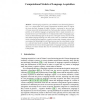Free Online Productivity Tools
i2Speak
i2Symbol
i2OCR
iTex2Img
iWeb2Print
iWeb2Shot
i2Type
iPdf2Split
iPdf2Merge
i2Bopomofo
i2Arabic
i2Style
i2Image
i2PDF
iLatex2Rtf
Sci2ools
CICLING
2010
Springer
2010
Springer
Computational Models of Language Acquisition
Abstract. Child language acquisition, one of Nature’s most fascinating phenomena, is to a large extent still a puzzle. Experimental evidence seems to support the view that early language is highly formulaic, consisting for the most part of frozen items with limited productivity. Fairly quickly, however, children find patterns in the ambient language and generalize them to larger structures, in a process that is not yet well understood. Computational models of language acquisition can shed interesting light on this process. This paper surveys various works that address language learning from data; such works are conducted in different fields, including psycholinguistics, cognitive science and computer science, and we maintain that knowledge from all these domains must be consolidated in order for a well-informed model to emerge. We identify the commonalities and differences between the various existing approaches to language learning, and specify desiderata for future research that ...
Child Language Acquisition | CICLING 2010 | Language Acquisition | Language Learning | Natural Language Processing |
| Added | 18 May 2010 |
| Updated | 18 May 2010 |
| Type | Conference |
| Year | 2010 |
| Where | CICLING |
| Authors | Shuly Wintner |
Comments (0)

